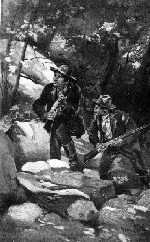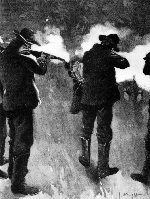


 Mention the words Kentucky Hillbilly to most people,
and the first thoughts that come to mind will probably be feuding mountaineers.
Almost everyone has heard of the Hatfield-McCoy feud. It has been sung in
songs, told in countless stories, and there was even a Bugs Bunny cartoon
once that used the preface.
Mention the words Kentucky Hillbilly to most people,
and the first thoughts that come to mind will probably be feuding mountaineers.
Almost everyone has heard of the Hatfield-McCoy feud. It has been sung in
songs, told in countless stories, and there was even a Bugs Bunny cartoon
once that used the preface.
How much of what you have heard is fact, and how much is just the romanticism of writers trying to make a good story?
In the case of the Hatfield - McCoy feud there was a love affair between two members of the opposing families, sort of a "Romeo and Juliet of the hills" story, and the eastern press played it to the hilt! It's not hard to find information about that particular feud, although individual accounts vary. I have seen one page that said there were more than one hundred killed in the Hatfield - McCoy feud, when most all personal and legal accounts agree the number was more like a dozen.
"Devil Anse" Hatfield was not above using the family's celebrity status. Here the Hatfield clan poses for a passing photographer several years after the feud. Note that even one of the children is given a gun to hold in order to more fit the image.
The real truth about many of the the Kentucky feuds, lies somewhere with the real people who lived these events.
Several major feuds were fought that never recieved the same kind of national attention as the Hatfield-McCoy conflict. Some much worse.
 During the decade preceding and for a half-century
after the Civil War, a series of feuds swept the hills of Eastern Kentucky
like wild-fire. Several times, local government came to a standstill and
law enforcement was impossible. State troops were repeatedly called in to
protect lives and allow courts to operate. At one point, relations with
neighboring West Virginia became so bad over a border dispute, it was feared
the two states would fight.
During the decade preceding and for a half-century
after the Civil War, a series of feuds swept the hills of Eastern Kentucky
like wild-fire. Several times, local government came to a standstill and
law enforcement was impossible. State troops were repeatedly called in to
protect lives and allow courts to operate. At one point, relations with
neighboring West Virginia became so bad over a border dispute, it was feared
the two states would fight.
The feuds were not as bloody or as violent as the national press reported at the time, and many writings about the time are based more on legend than fact. However, they were sufficient to reinforce Kentucky's reputation as "the dark and bloody ground" and paint a lasting and hurtful image of the Kentucky mountaineer as an uncouth hillbilly with a slouch hat and overalls, a full beard, a rifle, and a jug of whiskey.
The mountaineers fondness for firearms comes from the frontier dependency on them for food and self preservation. Even after the frontier had been "tamed", families living far from the sheriff often had to depend on their own resources for protection.
A lot of different people have tried to explain why the feuds were confined to such a small part of Eastern Kentucky. Some say it was the Civil War and the fact that so many of Kentucky's sons fought on both sides, but there are definite time frame problems with that premise. The Hill-Evans feud began in 1824 and ended in 1852 more than a decade before the war. The bloody Baker-White feud, or Clay County War as it is sometimes known, began five years before and lasted in one form or another until 1932.
Sociologists have said it was the isolation of the hill communities and too little influence from church and schools. But West Virginia , Tennessee, western North Carolina, and southwestern Virginia had the same type of terrain and were also isolated and none were caught up in feuding as was Kentucky. Most of these settlers shared a common Scotch-Irish background, but there is no evidence that clan rivalries brought over from the old country had anything to do with it.
The fact is, I believe, these folks who had lived in relative obscurity for so many generations, had developed their own cultures and ways of existing within the hard world in which they made their homes. These rules were often written in the blood of those who first came to the frontier seeking to better their lives and have something to call their own.
A man's word, and the honor of his family name, were about all he had on which to base a relationship with neighbors he might see only every few weeks. Most business deals or trades, were sealed with a handshake. Even today, because this is still a fairly sparsley populated county, if you start talking to someone many will want to know,"Who's boy/girl are you?". Their first impression may well be based upon what they know of your family.
If a man was found to be a thief, coward or a liar, he was shunned. To cast doubts on someones honesty, or his family, was to invite swift retribution. If a person did not stand up for himself or his own family, how could he be expected to hold his ground when things got really tough?
After the Civil War, things began to change very quickly. Eastern land companies began buying up huge tracts of the hills for timber. Coal mines were opening, and railroads started cutting through the heart of the mountains bringing new people, new customs and mannerisms. Where once there had been only a few scattered cabins, suddenly sprang up towns with stores. The mountaineer had to find ways of adjusting to rapidly changing surroundings without sacrificing familiar ways and traditions.
The combination all these social and economic factors combined with the weakness of law enforcement, the scarcity of churches and schools and the tremendous family influences born of their isolation, led to a situation where the potential for violence over seemingly minor troubles was very real.
By far the worst was the Martin-Tolliver feud, or the Rowan County War as it is sometimes called. Politics and liquor can be said to have been the start of this the bloodiest of the Kentucky feuds. At one point the state legislators even proposed abolishing the county in hopes of stopping it, but none of the surrounding counties wanted any part of it! Over a period of four years, from 1883-87, twenty men were killed and sixteen wounded, surpassing the famous Hatfield-McCoy feud's tally of a dozen killed in around ten years. The final battle lasted over two hours and an estimated fifteen-hundred rounds were fired. Tolliver died on the streets of Morehead in his stocking feet when he ran out with his guns blazing. Most of his faction was killed as well.
Whatever the reasons for their beginnings, the feuds took a terrible toll for half a century. Hundreds of people, including civic and political leaders were killed, and hundreds more were injured. For forty years local delegations periodically went to Frankfort to ask for help in restoring law and order.
Businesses were destroyed and education was poor. Eastern Kentuckians were shunned even by other Kentuckians and the image of the backward, drunken, killer mountaineer was ingrained into a nations memory and has been passed down from generation to generation.
The influence of eastern Kentucky in state affairs was diminished considerably, adding even more to the cultural isolation of the region by making it much more difficult to obtain the state support necessary to procure funds for roads, and schools so desperately needed and perpetuating it's reputation for violence.
There are many areas in the eastern part of the state that still show the effects of that further isolation. Poverty is rampant and that image of the stereo-typical hillbilly still exists in the minds of many. It is slowly being destroyed as education and persistance pay off. We are a proud people in the foothills of Kentucky and the independant nature of our fore-fathers still exists in a lot of us. No, we can never erase the violence in our past, but we can learn from it and move forward toward our true potential.

Resources and suggested reading

